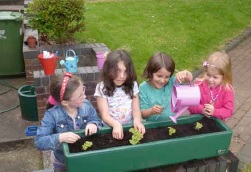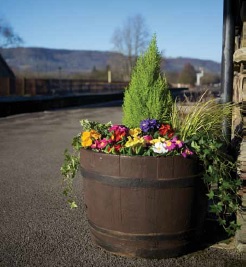Transforming your site with containers
Patience Atkinson-Gregory, MD of horticultural supplier Amberol (www.amberol.co.uk) explains how to make the most of containers on your site.
We all know that appearances are important. With universities and colleges competing for students, one way of creating a great impression on potential students and their parents on visits and open days is to make your site look good. Some organisations have a natural advantage: if you are in a rural location with spacious grounds surrounded by rolling hills, it’s relatively simple to create and maintain an attractive site.
However, more urban environments or a 1960s concrete-dominated campus presents more of a challenge. This is where container gardening can have a significant impact, enabling you to create attractive floral displays that can transform an otherwise uninspiring area. Furthermore, containers are often used to grow edible plants – a practice that is becoming more popular as many educational establishments strive to achieve greater levels of sustainability. The University of St Andrews for example has set up an ‘Edible Campus’ drive, whilst the University of Roehampton’s ‘Growhampton’ project has resulted in the creation of student led growing spaces with a container garden yielding edible produce that is used in a campus café.
Why use containers?
Containers offer the benefits of flexibility, control and mobility, making it easier to grow a wide variety of plants anywhere. Containers can be placed according to plant type and preference, in sunny or shady conditions. You can use whichever type of soil best suits your purposes and it’s also easier to reduce weeds and prevent damage from disease and garden pests in the controlled environment that containers provide.
Getting started
Whilst growing plants in containers isn’t difficult, there are ways of reducing the maintenance involved and of ensuring the best results. Ultimately, you are aiming to create the ideal growing conditions for whatever you plant. As with most projects, preparation is key.
Drainage: Waterlogged plants don’ thrive, so ensure that containers have adequate drainage. Even if a planter has pre-existing holes, you may wish to create additional ones. Self-watering containers are the exception: they don’t have drainage holes because the specialised design means that plants are able to access moisture as and when needed. The containers that we have developed have a capillary action matting system that facilitates the dispersal of water only when required by the plant.
Soil: the ability to choose and vary the soil that you use is particularly helpful in an area with poor quality soil. Container gardening is all about maximising growing conditions and so using the right soil is crucial for optimal growth. Flexibility is also important as plants favour different conditions. For example, lettuce like finely worked soil whilst runner beans will tolerate a coarser texture. Most plants will grow in multipurpose compost, although perennials and shrubs prefer a loam-based compost which is heavier and offers increased stability.
Making the right choice
There are many styles and sizes of containers on the market, made from a wide variety of materials. Whilst aesthetics are important, there are other factors to consider such as durability and maintenance when making a selection.
Plastic: flexible and hardy, plastic is a great choice. It doesn’t dry out as much as clay or terracotta, whilst the appearance of plastic containers has radically improved in recent years. Some even look like wood or terracotta, but with the increased durability that plastic offers. With sustainability in mind, many containers are now made from recyclable polyethylene.
Glazed ceramic and terracotta: clay and terracotta pots are attractive, but they dry out faster than plastic. They are also prone to cracking when exposed to severe or prolonged frost so look out for frost-proof pots. Positioning pots on feet can help reduce the risk of frost damage.
Wood: another attractive material which enhances the integration with the natural environment. However, it does rot over time. Treating the wood and lining containers with punctured plastic sheeting can help extend longevity. Half barrels are often used for growing fruit trees.
Metal: contemporary and attractive, metal containers have become increasingly popular. They are practical as they don’t crack in the cold or rot. However, they are susceptible to external temperatures, heating and cooling quickly.
Self-watering: creating optimal conditions for growth, self-watering containers have a sub-soil water reservoir. Evaporation is kept to a minimum and the roots absorb only what they need, facilitating optimal growth. Designed for easy maintenance, each container has a filling point which rarely needs to be topped up more than once a week.

Keeping on top of maintenance
Whilst containers make it easy to grow a whole range of flowers and edibles, proper maintenance is still important to ensure maximum flowering or cropping.
Deadheading: Regular deadheading of flowering plants will help them bloom for longer as all the nutrients and energy go into making flowers rather than producing seeds.
Pruning: shrubs or climbing plants should be regularly pruned to maintain health and shape. Pruning also eliminates damaged and diseased parts of the plant. The degree of pruning varies from plant to plant.
Feeding: Container plants need additional nutrients and should be topped up with fertiliser approximately once every two weeks. You may wish to adjust the frequency of feeding depending upon how your plants respond. They can be fed by adding fertiliser to the soil, using a slow release fertiliser or by spraying leaves with doubly diluted solutions.
Watering: a major disadvantage of container gardening is the fact that the soil is more likely to dry out and so plants may need more frequent watering. This can be resolved by using self-watering containers that require topping up only once a week.
What can you grow?
The list of plants that grow well in containers is long and diverse - these are just a few.
 Vegetables
Vegetables
Lettuce: prefers shade in the summer and a well-drained soil. Don’t plant too densely and watch out for aphid attacks.
Potatoes: best grown from seed potatoes or tubers. There are many varieties of potato. For example, first earlies can be planted from February onwards and should produce a crop within about three months. Second earlies are planted a few weeks later and take three to four months to mature. Potatoes grow best using a crop rotation system and root vegetables do well in the same soil after potatoes have grown there.
Tomatoes: best planted in larger containers and should be placed around 50-60cm apart. The stem should be tied to a vertical cane although some types can be grown in hanging baskets. Soil should be kept moist and plants should be fed with fertiliser fortnightly.
Spring onions: easy to grow from seed, these perennial vegetables provide a high yield in minimal space. They have shallow root systems and can be grown in small pots as well as with other vegetables. They like well-drained soil in a sunny position. Try planting a salad garden in one large container, which could include lettuce, spring onions, chives and tomatoes.
Herbs
Many grow well in containers. Most prefer a sunny, sheltered position in well-drained soil and may need protecting from frost during colder months. For example, parsley germinates slowly in warm conditions and requires a rich soil in partial shade whilst mint tolerates shade and moist soil. It is an invasive plant, so growing it in pots can contain it.
Fruit
Many varieties of fruit such as apples, pears, cherries and blueberries grow well in containers. Small fruit trees and bushes can be planted throughout the year, although spring is the optimum time. Again, good quality compost is essential and include fertiliser pellets and/or feed fortnightly to maximise cropping. Fruit is usually best planted in a sunny location and should be kept well watered with the compost surface allowed to dry out between watering.
Flowering plants
Many flowering plants thrive in containers and with a variety of heights, sizes and styles available, it is easy to create a stunning display. Planting warm weather annuals will ensure a long lasting display. Geraniums, marigolds, begonias, sweet pea, fuchsia and lobelia are all good choices. Dwarf cannas and dwarf dahlias are suitable for larger containers. Some rose varieties don’t grow well in containers so it’s important to choose the right type such as a patio or miniature rose for ground cover. Roses need deep containers to accommodate their roots. Edible flowers such as marigolds and nasturtiums grow well in containers and make a great display.
So, don’t discount containers as too high maintenance or too limited to work on your site. It’s true, they can’t match some stunning natural surroundings, but they can transform an environment for the better - or significantly enhance the landscape that you have already created.
About the author
Patience Atkinson-Gregory is MD of horticultural manufacturer Amberol. Who supply a wide range of planters, self-watering containers, benches and litter bins (including speaking ones) to universities, schools, local authorities and businesses. For more information, visit www.amberol.co.uk


